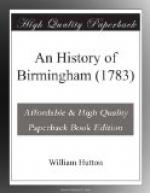The moat, like others on an eminence, has but one trench, fed by the land springs; is filled up in the front of the hall, as there is not much need of water protection. The house, which gives an idea of former gentility, seems the first erected on the spot; is irregular, agreeable to the taste of the times, and must have been built many centuries. All the ancient furniture fled with its owners, except an hatchment in the hall, with sixteen coats of arms, specifying the families into which they married.
KING’S-HURST.
Two furlongs east of Sheldon-hall, and one mile south of Castle Bromwich, is Kings-hurst; which, though now a dwelling in tenancy, was once the capital of a large track of land, consisting of its own manor, Coleshill, and Sheldon; the demesne of the crown, under the Saxon kings, from whom we trace the name.
The Conqueror, or his son William, granted it; but whether for money, service, caprice, or favour, is uncertain; for he who wears a crown acts as whimsically as he who does not.
Mountfort came over with William, as a knight, and an officer of rank; but, perhaps, did not immediately receive the grant, for the king would act again much like other people, give away their property, before he would give away his own.
If this unfortunate family were not the first grantees, they were lords, and probably residents of King’s-hurst, long before their possession of Coleshill, in 1332, and by a younger branch, long after the unhappy attainder of Sir Simon, in 1497.
Sir William Mountfort, in 1390, augmented the buildings, erected a chapel, and inclosed the manor. His grandson, Sir Edmund, in 1447, paled in some of the land, and dignified it with the fashionable name of park.
This prevailing humour of imparking was unknown to the Saxons, it crept in with the Norman: some of the first we meet with are those of Nottingham, Wedgnock, and Woodstock—Nottingham, by William Peveral, illegitimate son of the Conqueror; Wedgnock, by Newburg, the first Norman Earl of Warwick; and Woodstock, by Henry the First. So that the Duke of Marlborough perhaps may congratulate himself with possessing the oldest park in use.
The modern park is worth attention; some are delightful in the extreme: they are the beauties of creation, terrestrial paradises; they are just what they ought to be, nature cautiously assisted by invisible art. We envy the little being who presides over one—but why mould we envy him? the pleasure consists in seeing, and one man may see as well as another: nay, the stranger holds a privilege beyond him; for the proprietor, by often seeing, sees away the beauties, while he who looks but seldom, sees with full effect. Besides, one is liable to be fretted by the mischievous hand of injury, which the stranger seldom sees; he looks for excellence, the owner for defect, and they both find.




